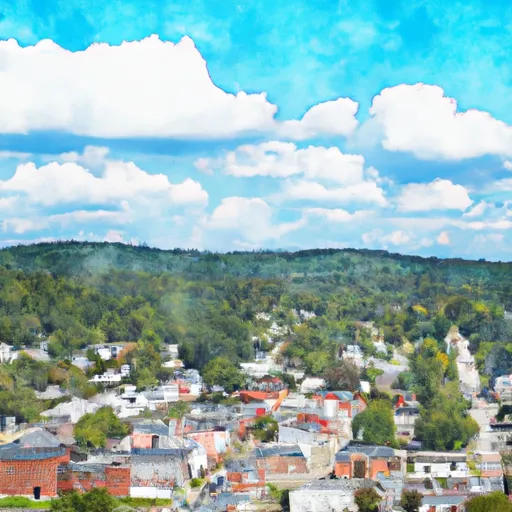-
 Snoflo Premium
Snoflo Premium
Get unlimited access to all our content
With no Ad interruptions! - Start Your Free Trial Login with existing account
Myersville
Eden Index
Climate
9.8
•
Recreation
7.5
•
Community
2.9
•
Safeguard
7.2/10

Myersville, located in Frederick County, Maryland, is a charming town known for its picturesque scenery and diverse recreational opportunities. The climate in Myersville is characterized by four distinct seasons. Summers are warm and humid, with average temperatures ranging from the mid-70s to low 80s Fahrenheit. Winters are cold, with temperatures averaging in the mid-30s. Spring and fall offer mild temperatures, making them ideal for outdoor activities.
Hydrologically, the area is influenced by the nearby Monocacy River, which offers opportunities for fishing, boating, and kayaking. The river is home to a variety of fish species, including bass and trout, attracting anglers from near and far. Additionally, Myersville is surrounded by lush forests, rolling hills, and scenic trails, making it a haven for hikers, bikers, and nature enthusiasts. The nearby Gambrill State Park and Catoctin Mountain Park provide ample opportunities for outdoor recreation, including hiking, camping, and wildlife observation.
Whether you enjoy fishing in the Monocacy River, exploring the picturesque trails, or simply immersing yourself in the natural beauty, Myersville offers a wide range of outdoor activities for residents and visitors alike.
What is the Eden Index?
The Snoflo Eden Index serves as a comprehensive rating system for regions, evaluating their desirability through a holistic assessment of climate health, outdoor recreation opportunities, and natural disaster risk, acknowledging the profound impact of these factors on livability and well-being.
Climate Health Indicator (CHI): 9.8
Myersville receives approximately
1111mm of rain per year,
with humidity levels near 77%
and air temperatures averaging around
12°C.
Myersville has a plant hardyness factor of
7, meaning
plants and agriculture in this region tend to thrive during the non-winter months.
By considering the ideal temperature range, reliable water supplies, clean air, and stable seasonal rain or snowpacks, the Climate Health Indicator (CHI) underscores the significance of a healthy climate as the foundation for quality living.
A healthy climate is paramount for ensuring a high quality of life and livability in a region, fostering both physical well-being and environmental harmony. This can be characterized by ideal temperatures, reliable access to water supplies, clean air, and consistent seasonal rain or snowpacks.
Weather Forecast
Streamflow Conditions
Potomac
Area Rivers
Potomac
Snowpack Depths
Potomac
Reservoir Storage Capacity
Potomac
Groundwater Levels
Recreational Opportunity Index (ROI): 7.5
The Recreational Opportunity Index (ROI) recognizes the value of outdoor recreational options, such as parks, hiking trails, camping sites, and fishing spots, while acknowledging that climate plays a pivotal role in ensuring the comfort and consistency of these experiences.
Access to outdoor recreational opportunities, encompassing activities such as parks, hiking, camping, and fishing, is crucial for overall well-being, and the climate plays a pivotal role in enabling and enhancing these experiences, ensuring that individuals can engage in nature-based activities comfortably and consistently.
Camping Areas
| Campground | Campsites | Reservations | Toilets | Showers | Elevation |
|---|---|---|---|---|---|
| Prince William Forest RV Campground | 24 | 270 ft | |||
| Lunga Park Military - Quantico MCB | None | 303 ft | |||
| Gambrill State Park | 34 | 1,186 ft | |||
| Owens Creek - Catoctin Mountain National Park | None | 1,389 ft | |||
| Manor Area - Cunningham Falls State Park | 40 | 561 ft | |||
| Oak Ridge - Prince William Forest Park | None | 364 ft | |||
| Greenbrier State Park | 165 | 909 ft | |||
| Bull Run Regional Park | None | 156 ft | |||
| Brunswick City Campground | None | 219 ft | |||
| Houck Area - Cunningham Falls State Park | 140 | 1,129 ft |
Nearby Fishing
Nearby Ski Areas
Catastrophe Safeguard Index (CSI):
The Catastrophe Safeguard Index (CSI) recognizes that natural disaster risk, encompassing floods, fires, hurricanes, and tornadoes, can drastically affect safety and the overall appeal of an area.
The level of natural disaster risk in a region significantly affects safety and the overall livability, with climate change amplifying these risks by potentially increasing the frequency and intensity of events like floods, fires, hurricanes, and tornadoes, thereby posing substantial challenges to community resilience and well-being.
Community Resilience Indicator (CRI): 2.9
The Community Resilience Indicator (CRI) recognizes that education, healthcare, and socioeconomics are crucial to the well-being of a region. The CRI acknowledges the profound impact of these elements on residents' overall quality of life. By evaluating educational resources, healthcare accessibility, and economic inclusivity, the index captures the essential aspects that contribute to a thriving community, fostering resident satisfaction, equity, and social cohesion.

